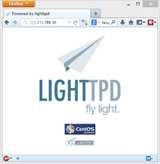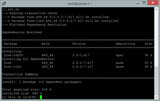Installer Plesk på CentOS 7
Bruger du et andet system? Plesk er et proprietært webhost kontrolpanel, der giver brugerne mulighed for at administrere deres personlige og/eller klienters websteder, databaser
Paste 2.1 is a simple and flexible, free and open source pastebin application for storing code, text and more. It was initially forked from the freely available original source code used by pastebin.com before the domain was sold in 2010. Since that time, the Paste developers have added lots of improvements and features such as a featureful Admin Dashboard with site statstics and settings, IP and user bans, the ability to selectively delete pastes, user accounts with social integration, profile pages, and all of the usual extras such as syntax highlighting for the majority of languages, configurable paste limits and much more.
In this tutorial we are going to install Paste 2.1 on a CentOS 7 LAMP VPS using Apache web server, PHP 7.1, and a MariaDB database.
We will start by adding a new sudo user.
First, log into your server as root:
ssh root@YOUR_VULTR_IP_ADDRESS
Add a new user called user1 (or your preferred username):
useradd user1
Next, set the password for the user1 user:
passwd user1
When prompted, enter a secure and memorable password.
Now check the /etc/sudoers file to make sure that the sudoers group is enabled:
visudo
Look for a section like this:
%wheel ALL=(ALL) ALL
This line tells us that users who are members of the wheel group can use the sudo command to gain root privileges. It will be uncommented by default so you can simply exit the file.
Next we need to add user1 to the wheel group:
usermod -aG wheel user1
We can verify the user1 group membership and check that the usermod command worked with the groups command:
groups user1
Now use the su command to switch to the new sudo user user1 account:
su - user1
The command prompt will update to indicate that you are now logged into the user1 account. You can verify this with the whoami command:
whoami
Now restart the sshd service so that you can login via ssh with the new non-root sudo user account you have just created:
sudo systemctl restart sshd
Exit the user1 account:
exit
Exit the root account (which will disconnect your ssh session):
exit
You can now ssh into the server instance from your local host using the new non-root sudo user user1 account:
ssh user1@YOUR_VULTR_IP_ADDRESS
If you want to execute sudo without having to type a password every time, then open the /etc/sudoers file again, using visudo:
sudo visudo
Edit the section for the wheel group so that it looks like this:
%wheel ALL=(ALL) NOPASSWD: ALL
Please note: Disabling the password requirement for the sudo user is not a recommended practice, but it is included here as it can make server configuration much more convenient and less frustrating, especially during longer systems administration sessions. If you are concerned about the security implications, you can always revert the configuration change to the original after you finish your administration tasks.
Whenever you want to log into the root user account from within the sudo user account, you can use one of the following commands:
sudo -i
sudo su -
You can exit the root account and return back to your sudo user account any time by simply typing:
exit
Before installing any packages on the CentOS server instance, we will first update the system.
Make sure you are logged in to the server using a non-root sudo user and run the following command:
sudo yum -y update
Install the Apache web server:
sudo yum -y install httpd
Then use the systemctl command to start and enable Apache to execute automatically at boot time:
sudo systemctl enable httpd
sudo systemctl start httpd
Check your Apache configuration file to ensure that the DocumentRoot directive points to the correct directory:
sudo vi /etc/httpd/conf/httpd.conf
The DocumentRoot configuration option will look like this:
DocumentRoot "/var/www/html"
Now, let's make sure that the mod_rewrite Apache module is loaded. We can do this by searching the Apache base modules configuration file for the term "mod_rewrite".
Open the file:
sudo vi /etc/httpd/conf.modules.d/00-base.conf
Search for the term mod_rewrite.
If the mod_rewrite Apache module is loaded, you will find a configuration line looking like this:
LoadModule rewrite_module modules/mod_rewrite.so
If the above line starts with a semi-colon, you will need to remove the semi-colon to uncomment the line and load the module. This, of course, applies to any other required Apache modules too.
We now need to edit Apache's default configuration file so that mod_rewrite will work correctly with the Paste app.
Open the file:
sudo vi /etc/httpd/conf/httpd.conf
Then find the section that starts with <Directory "/var/www/html"> and change AllowOverride none to AllowOverride All. The end result (with all comments removed) will look something like this:
<Directory "/var/www/html">
Options Indexes FollowSymLinks
AllowOverride All
Require all granted
</Directory>
Now save and close the Apache configuration file.
We will restart Apache at the end of this tutorial, but restarting Apache regularly during installation and configuration is certainly a good habit, so let's do it now:
sudo systemctl restart httpd
We now need to open the default HTTP and HTTPS ports as they will be blocked by firewalld by default.
Open the firewall ports:
sudo firewall-cmd --permanent --add-port=80/tcp
sudo firewall-cmd --permanent --add-port=443/tcp
Reload the firewall to apply the changes:
sudo firewall-cmd --reload
You will see the word success displayed in your terminal after each successful firewall configuration command.
We can quickly verify that the Apache HTTP port is open by visiting the IP address or domain of the server instance in a browser:
http://YOUR_VULTR_IP_ADDRESS/
You will see the default Apache web page in your browser.
SELinux stands for "Security Enhanced Linux". It is a security enhancement to Linux which allows users and administrators more control over access control. It is disabled by default on Vultr CentOS 7 instances, but we will cover the steps to disable it, just in case you are not starting from a clean install and it was previously enabled.
To avoid file permission problems with the Paste app we need to ensure that SELinux is disabled.
First, let's check whether SELinux is enabled or disabled with the sestatus command:
sudo sestatus
If you see something like: SELinux status: disabled then it is definitely disabled and you can skip straight to Step 6. If you see any other message, then you will need to complete this section.
Open the SELinux configuration file with your favourite terminal editor:
sudo vi /etc/selinux/config
Change SELINUX=enforcing to SELINUX=disabled and then save the file.
To apply the configuration change, SELinux requires a server reboot, so you can either restart the server using the Vultr control panel or you can simply use the shutdown command:
sudo shutdown -r now
When the server reboots, your SSH session will get disconnected and you may see a message informing you about a 'broken pipe' or 'Connection closed by remote host'. This is nothing to worry about, simply wait for 20 seconds or so and then SSH back in again (with your own username and domain):
ssh user1@YOUR_DOMAIN
Or (with your own username and IP address):
ssh user1@YOUR_VULTR_IP_ADDRESS
Once you have logged back in, you should check the status of SELinux again with the sestatus command to make sure it is properly disabled:
sudo sestatus
You should see a message saying SELinux status: disabled. If you see a message saying SELinux status: enabled (or something similar) you will need to repeat the above steps and ensure that you properly restart your server.
CentOS 7 requires us to add an external repo in order to install PHP 7.1, so run the following command:
sudo rpm -Uvh https://mirror.webtatic.com/yum/el7/webtatic-release.rpm
We can now install PHP 7.1 along with all of the necessary PHP modules required by the Paste app:
sudo yum -y install php71w php71w-gd php71w-mbstring php71w-mysql php71w-xml php71w-common php71w-pdo php71w-mysqlnd
CentOS 7 defaults to using MariaDB database server, which is an enhanced, fully open source, community developed, drop-in replacement for MySQL server.
Install MariaDB database server:
sudo yum -y install mariadb-server
Start and enable MariaDB server to execute automatically at boot time:
sudo systemctl enable mariadb
sudo systemctl start mariadb
Secure your MariaDB server installation:
sudo mysql_secure_installation
The root password will be blank, so simply hit enter when prompted for the root password.
When prompted to create a MariaDB/MySQL root user, select "Y" (for yes) and then enter a secure root password. Simply answer "Y" to all of the other yes/no questions as the default suggestions are the most secure options.
Log into the MariaDB shell as the MariaDB root user by running the following command:
sudo mysql -u root -p
To access the MariaDB command prompt, simply enter the MariaDB root password when prompted.
Run the following queries to create a MariaDB database and database user for Paste:
CREATE DATABASE paste_db CHARACTER SET utf8 COLLATE utf8_general_ci;
CREATE USER 'paste_user'@'localhost' IDENTIFIED BY 'UltraSecurePassword';
GRANT ALL PRIVILEGES ON paste_db.* TO 'paste_user'@'localhost';
FLUSH PRIVILEGES;
EXIT;
You can replace the database name paste_db and username paste_user with something more to your liking, if you prefer. (Please note that the default maximum length for usernames in MariaDB on CentOS 7 is 16 characters). Also, make sure that you replace "UltraSecurePassword" with an actually secure password.
Change your current working directory to the default web directory:
cd /var/www/html/
If you get an error message saying something like 'No such file or directory' then try the following command:
cd /var/www/ ; sudo mkdir html ; cd html
Your current working directory will now be: /var/www/html/. You can check this with the pwd (print working directory) command:
pwd
Now use wget to download the Paste installation package:
sudo wget --content-disposition https://sourceforge.net/projects/phpaste/files/latest/download?source=files
Please note: You should definitely check for the most recent version by visiting the Paste download page.
List the current directory to check that you have successfully downloaded the file:
ls -la
Let's quickly install unzip so we can unzip the file:
sudo yum -y install unzip
Now uncompress the zip archive:
sudo unzip paste-2.1.zip
Change ownership of the web files to avoid any permissions problems:
sudo chown -R apache:apache * ./
Restart Apache again:
sudo systemctl restart httpd
Now we're ready to move on to the final step.
It's time to visit the IP address of your server instance in your browser, or if you've already configured your Vultr DNS settings (and given it enough time to propagate) you can simply visit your domain instead.
To access the Paste installation page, enter your Vultr instance IP address into your browser address bar, followed by /install/:
http://YOUR_VULTR_IP_ADDRESS/install/
Most of the installation options are self explanatory, but here are a few pointers to help you along:
Ensure that the Pre-installation checks are all green. Specifically, the following 3 files must be writable:
config.php
tmp/temp.tdata
sitemap.xml
Enter the following DATABASE INFORMATION:
Hostname: localhost
Database Name: paste_db
Username: paste_user
Password: UltraSecurePassword
Make a note of the key value and store it in a safe place, then click Install to continue.
Enter the following Administrator details:
Username: admin
Password: <secure admin password>
Click Submit to finalize the installation.
To access the admin section simply click on the dashboard button and enter your username and password. If you aren't redirected to the admin login page, you can enter the admin address manually:
http://YOUR_VULTR_IP_ADDRESS/admin/
For security reasons, make sure you delete the /install/ directory from the webroot directory:
sudo rm -rf ./install
If you get an error message when trying to delete the /install/ directory, simply change the permissions of the webroot and try again:
sudo chmod 755 .
sudo rm -rf ./install
You are now ready to start administering your own personal pastebin site.
Bruger du et andet system? Plesk er et proprietært webhost kontrolpanel, der giver brugerne mulighed for at administrere deres personlige og/eller klienters websteder, databaser
Squid er et populært, gratis Linux-program, der giver dig mulighed for at oprette en webproxy til videresendelse. I denne vejledning vil du se, hvordan du installerer Squid på CentOS for at gøre dig
Introduktion Lighttpd er en forgrening af Apache, der sigter mod at være meget mindre ressourcekrævende. Den er let, deraf navnet, og den er ret enkel at bruge. Installer
VULTR har for nylig foretaget ændringer i deres ende, og alt skulle nu fungere fint ud af boksen med NetworkManager aktiveret. Skulle du ønske at deaktivere
Icinga2 er et kraftfuldt overvågningssystem, og når det bruges i en master-klient-model, kan det erstatte behovet for NRPE-baserede overvågningstjek. Mester-klienten
Bruger du et andet system? Apache Cassandra er et gratis og open source NoSQL-databasestyringssystem, der er designet til at give skalerbarhed, høj
Bruger du et andet system? Microweber er en open source træk og slip CMS og online shop. Microweber-kildekoden er hostet på GitHub. Denne guide vil vise dig
Bruger du et andet system? Mattermost er et open source, selvhostet alternativ til Slack SAAS-meddelelsestjenesten. Med andre ord, med Mattermost er du ca
Hvad skal du bruge En Vultr VPS med mindst 1 GB RAM. SSH-adgang (med root/administrative rettigheder). Trin 1: Installation af BungeeCord Første ting først
Plesk-kontrolpanelet har en meget flot integration til Lets Encrypt. Lets Encrypt er en af de eneste SSL-udbydere, der udleverer certifikater komplet
Lets Encrypt er en certifikatmyndighed dedikeret til at levere SSL-certifikater gratis. cPanel har bygget en pæn integration, så du og din klient
Bruger du et andet system? Concrete5 er et open source CMS, som tilbyder mange karakteristiske og nyttige funktioner til at hjælpe redaktører med at producere indhold nemt og
Bruger du et andet system? Review Board er et gratis og open source-værktøj til gennemgang af kildekode, dokumentation, billeder og mange flere. Det er webbaseret software
I denne vejledning lærer du, hvordan du opsætter HTTP-godkendelse for en Nginx-webserver, der kører på CentOS 7. Krav For at komme i gang skal du bruge
YOURLS (Your Own URL Shortener) er en open source URL-forkortelse og dataanalyseapplikation. I denne artikel vil vi dække installationsprocessen
Bruger du et andet system? Introduktion ArangoDB er en open source NoSQL-database med en fleksibel datamodel for dokumenter, grafer og nøgleværdier. det er
Introduktion /etc/-biblioteket spiller en afgørende rolle i den måde et Linux-system fungerer på. Årsagen til dette er, at næsten alle systemkonfigurationer
Mange systemadministratorer administrerer store mængder servere. Når filer skal tilgås på tværs af forskellige servere, logges ind på hver enkelt individuelt ca
Denne vejledning vil dække processen med at installere en Half Life 2-spilserver på CentOS 6 System. Trin 1: Installation af forudsætninger For at opsætte ou
Laravel GitScrum eller GitScrum er et open source-produktivitetsværktøj designet til at hjælpe udviklingsteams med at implementere Scrum-metoden på en måde, der ligner t.
Kunstig intelligens er ikke i fremtiden, det er her lige i nuet I denne blog Læs, hvordan kunstig intelligens-applikationer har påvirket forskellige sektorer.
Er du også et offer for DDOS-angreb og forvirret over forebyggelsesmetoderne? Læs denne artikel for at løse dine spørgsmål.
Du har måske hørt, at hackere tjener mange penge, men har du nogensinde spekuleret på, hvordan tjener de den slags penge? lad os diskutere.
Vil du se revolutionerende opfindelser fra Google, og hvordan disse opfindelser ændrede livet for ethvert menneske i dag? Læs derefter til bloggen for at se opfindelser fra Google.
Konceptet med selvkørende biler til at køre på vejene ved hjælp af kunstig intelligens er en drøm, vi har haft i et stykke tid nu. Men på trods af flere løfter er de ingen steder at se. Læs denne blog for at lære mere...
Efterhånden som videnskaben udvikler sig i et hurtigt tempo og overtager en stor del af vores indsats, stiger risikoen for at udsætte os selv for en uforklarlig Singularitet. Læs, hvad singularitet kunne betyde for os.
Opbevaringsmetoderne for dataene har været under udvikling, kan være siden fødslen af dataene. Denne blog dækker udviklingen af datalagring på basis af en infografik.
Læs bloggen for at kende forskellige lag i Big Data-arkitekturen og deres funktionaliteter på den enkleste måde.
I denne digitalt drevne verden er smarte hjemmeenheder blevet en afgørende del af livet. Her er et par fantastiske fordele ved smarte hjemmeenheder om, hvordan de gør vores liv værd at leve og enklere.
For nylig udgav Apple macOS Catalina 10.15.4 en supplerende opdatering for at løse problemer, men det ser ud til, at opdateringen forårsager flere problemer, hvilket fører til mursten af mac-maskiner. Læs denne artikel for at lære mere








